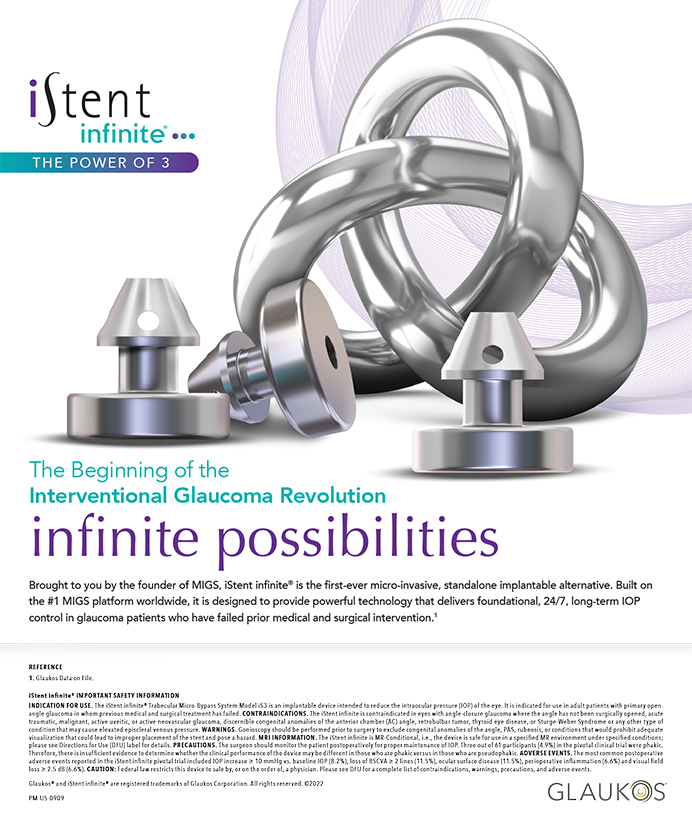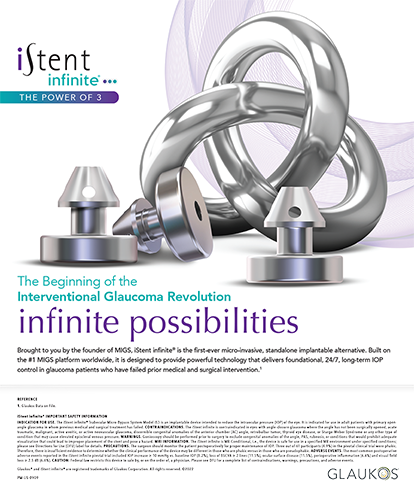The increased use of pre-LASIK automated corneal topography as a screening method for keratoconus has alerted ophthalmologists to the high prevalence of corneal pellucid marginal degeneration. Corneal specialists can now diagnose corneal pellucid marginal degeneration based on corneal topography devoid of any significant slit-lamp findings. Currently, many corneal specialists view keratoconus and corneal pellucid marginal degeneration as the same basic pathophysiology of the cornea but with a different primary focus (ie, inferocentral for keratoconus; generally inferior for corneal pellucid marginal degeneration). In the past, corneal pellucid marginal degeneration was only diagnosed at a very advanced state.
Assume that corneal pellucid marginal degeneration is diagnosed and LASIK is canceled, or PRK is performed successfully. How would a corneal specialist treat corneal pellucid marginal degeneration if it were progressive? This is a difficult clinical challenge and is similar to treating severe keratoconus. This article discusses treatment options.
TREATMENT
Contact Lens or Corneal Transplant
First, a corneal specialist may attempt to place a hard contact lens. If and when that fails, the surgeon is likely to entertain the need for a corneal transplant. A lamellar graft will not correct the irregular astigmatism because the foundation is too weak.
Penetrating Keratoplasty
Next, the surgeon may consider performing a penetrating keratoplasty (PKP). This surgery is a reasonable consideration except that the chance of very high astigmatism or wound dehiscence is likely due to the 7.5- to 10.0-mm optical zone area of the recipient cornea where the graft would be sutured because the recipient host cornea is very thin. The likelihood of very high astigmatism postoperatively and long-term ectasia is increased.
Lamellar Graft
In my opinion, the most helpful offering is to perform a large lamellar graft, decentered if necessary, that includes the areas of pathology inferiorly (Figure 1). This eccentric graft may even cross the limbus, and a surgeon can perform a peritomy in this area. This tectonic lamellar graft will not be effective visually but will serve to strengthen the cornea peripherally. About 3 months later, a surgeon can perform a well-centered PKP. The chances of a successful graft with a manageable amount of astigmatism are greatly enhanced.
Although surgeons may choose from many patterns for tectonic grafts, I believe that the method described earlier is much easier to perform because one can use the same trephine action on the patients and on the donor with an easy match. The use of templates to create sector and arcuate (crescentic) grafts is difficult, and few surgeons will take the time and effort to master this technique, which is infrequently used.
A surgeon can use a femtosecond laser to create the donor and recipient bed, which is a great advance in order to facilitate the surgery, but he must often deal with the scleral aspect of the recipient in a manual fashion. Dissecting the sclera of the donor and patient is not particularly difficult or dangerous. Matching the donor limbus to the recipient and using a peritomy allows for an excellent cosmetic result.
Keratoglobus
In severe cases of keratoglobus, enterprising corneal surgeons have used 16-mm-diameter tectonic lamellar and full-thickness corneal donors in order to save a patient's eye. In this day and age of advanced refractive surgery, a well-tested practice such as a tectonic corneal transplant is very useful in the treatment of corneal pellucid marginal degeneration. Although overall this two-step tectonic graft approach may take 3 months longer than a standard PKP, it is likely to decrease the overall time for the recovery of useful vision. If a primary PKP without a tectonic graft fails, then a secondary PKP will have an increased chance of failing with a much higher chance for complication.
CONCLUSION
Sometimes in corneal surgery, the preferred strategy requires planning for two procedures in to order to obtain a better result and decrease overall recovery time for the patient. The first procedure is utilized to reduce the risk and technical difficulty required for the second. A surgeon's imagination, technical skills and courage are often rewarded when treating challenging corneal problems.
Lee T. Nordan, MD, is a technology consultant for Vision Membrane Technologies, Inc., in San Diego. Dr. Nordan may be reached at (858) 487-9600; laserltn@aol.com.


